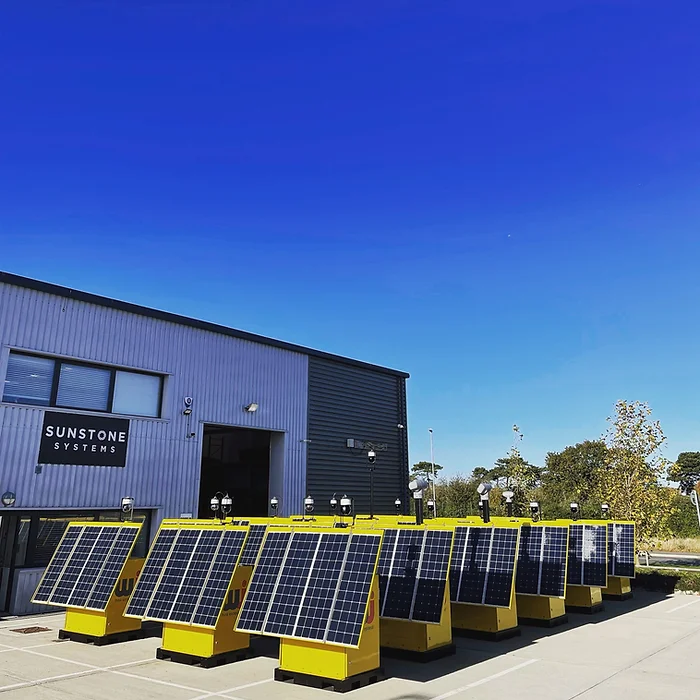Jump to:
Overview
Organisations are replacing diesel‑powered surveillance and site communications with solar platforms to cut emissions and operating costs. The WJ Sunstone Solar CCTV System demonstrates how a modern, off‑grid solution delivers reliable video, data, and connectivity without permanent power or fixed lines. As a result, operators can deploy monitoring and telecommunications rapidly, meet sustainability goals, and improve safety performance.

Why Solar‑Powered Security and Telecoms
Solar systems reduce Scope 1 emissions by removing diesel generation for power. They also lower noise, improve air quality, and minimise fuel logistics. Moreover, solar platforms shorten lead times because they avoid groundworks and cabling. Consequently, projects start faster and with fewer site dependencies. In addition, asset owners can scale capacity by adding units where demand is temporary or seasonal.
Architecture and Power Design
A robust solar platform integrates four core elements:
- High‑efficiency photovoltaic panels,
- Smart charge controllers and battery storage,
- Edge compute for video processing and device management, and
- Secure backhaul for data and voice.
This architecture supports day‑to‑day operations with multi‑day autonomy when sized correctly. Furthermore, intelligent power management prioritises critical functions during extended low‑light periods. Where required, hybrid options, including HVO‑compatible power stations, can provide resilience for extreme conditions.
Imaging, Sensing, and Analytics
The WJ Sunstone Solar CCTV System supports optical and thermal imaging for 24/7 detection. It pairs high‑resolution video with configurable bitrates to match power budgets and bandwidth constraints. Additionally, on‑device analytics can filter events, reduce false alarms, and optimise data usage. As a result, operators receive relevant alerts and maintain evidential quality recordings without excessive transmission overheads.
Backhaul and Interoperability
Off‑grid deployments must connect across varied environments. Therefore, systems commonly use 4G/5G as primary backhaul with satellite or private radio as contingency. Moreover, platforms can provide local Wi‑Fi for site teams and IoT sensors. Interoperable APIs allow integration with VMS, incident management, and asset systems. In addition, role‑based access controls and encryption protect data in transit and at rest.
Reliability, Security, and Compliance
Physical security measures deter theft and vandalism, including anti‑tamper housings and locked equipment bays. Likewise, remote health monitoring enables proactive maintenance, such as battery health checks and solar yield diagnostics. Firmware signing and regular updates reduce cyber risk. Moreover, audit logging supports regulatory compliance and evidential requirements. As a result, uptime improves while site visits decrease.
Deployment and Operations
Efficient rollout depends on consistent method statements and trained field teams. Site surveys verify solar access, mast placement, and camera coverage. Additionally, standardised mounting options speed installation on verges, compounds, and temporary worksites. Clear naming, asset tags, and configuration templates support fleet management at scale. Furthermore, centralised control rooms can coordinate alarm response, remote triage, and data retention policies.
Use Cases by Sector
- Highways: Short‑notice deployments for roadworks, incident hotspots, and worksite compounds.
- Rail: Trackside and station perimeters where power access is restricted.
- Construction: Site setup, remote entrances, and materials protection without generators.
- Oil & Gas: Perimeter monitoring and temporary compounds with strict emission controls.
- Security and Defence: Rapidly deployable surveillance in austere or off‑grid locations.
- Public Space: Parks, events, and temporary spaces where cabling is impractical.
Measuring Impact and Value
Decision‑makers should track both sustainability and operational metrics. Recommended KPIs include:
- Emissions avoided: litres of diesel displaced and associated CO₂e reduction.
- Uptime: percentage availability across imaging, analytics, and backhaul.
- Alert quality: event‑to‑action ratios and verified incident rates.
- Cost to serve: total cost per site per month, including call‑outs and fuel.
- Safety outcomes: incident reduction and time to resolution.
Circularity and End‑of‑Life
A sustainability programme should include battery lifecycle management and vendor‑supported recycling. Moreover, modular designs allow upgrades of cameras, radios, and storage without replacing the entire platform. As a result, assets remain in service longer and capital productivity improves. In addition, decommissioned units can be redeployed to new locations with minimal rework.
Procurement Checklist
To achieve reliable outcomes, procurement teams should:
- Define surveillance and communications objectives, including evidential standards.
- Specify power autonomy targets and any hybrid requirements.
- Confirm backhaul options, data retention, and integration needs.
- Set measurable KPIs for emissions, uptime, and response.
- Require security controls, patching cadence, and audit logs.
- Plan logistics for installation, training, and ongoing support.
- Include circularity, recycling, and redeployment provisions.
Furthermore, structured trials with pass/fail criteria reduce risk before scaling.
Solar‑powered surveillance and telecommunications platforms now meet mainstream operational requirements. The WJ Sunstone Solar CCTV System shows that off‑grid security can be sustainable, reliable, and cost‑effective. Moreover, the approach accelerates deployment, reduces fuel use, and improves safety across demanding sectors. Therefore, organisations seeking measurable environmental and operational gains should prioritise solar‑first designs with defined KPIs and clear support models.